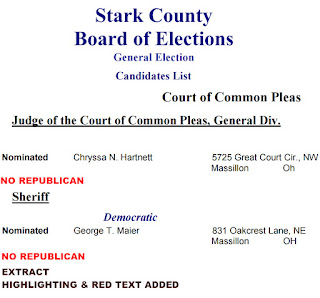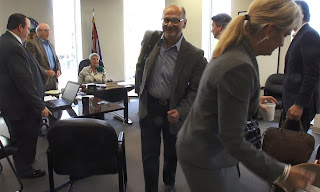UPDATED: 4:38 PM
PART 1
IN A SERIES
CAMPAIGN FINANCE REPORTS
STARK COUNTYWIDE RACES
WHO OWES WHOM IN STARK CO GOV'T & POLITICS?
Just take a look at this. (Note: all campaign finance data obtained from the Board of Elections)
Both Hartnett and Maier are running unopposed, to wit (Stark County Board of Elections' listing):
To the SCPR, Hartnett having raised no money in the pre-general campaign finance reporting (CFR) period makes a lot of sense and suggests she understands that it is important for judge to, on a relative basis, be as free from being subjected to contributors using political contributions as leverage in our Stark County justice system should a perceived need arise.
Of course, the gold standard for Stark County justice system candidates is Alliance Republican Jeff Jakmides (running for county prosecutor) who is self-financing, to wit:
Contrasted to Hartnett ($0 raised for "uncontested" election) and Jakmides (self-funded) of is Stark County sheriff George T. Maier is raising campaign finance money galore in a race against "nobody."
Only incumbent Democrat prosecutor candidate John Ferrero (Jakmides' opponent in a super contested race) has bested the uncontested George T. Maier.
And we all know the Watergate mantra: "Follow the Money!"
A focus of the series of blogs will be delving into the Maier contribution/expense CFR and trying to determine a reasonable explanation as to why an "uncontested" candidate for Stark countywide office would be far outraising (in terms of accepting money from other than themselves) those running in contested races.
Until he was defeated by the courageous former Stark County commissioner Thomas Bernabei last November, the SCPR thinks that William J. Healy, II was the master of applying a political calculus to practically everything he did as mayor of Canton.
It took a guy like Bernabei who has the moxie to stand off from "politics as usual" and who has the personal financial resources to have waged war on the Stark County/Ohio Democratic Parties on his right to run as an independent to take Healy down.
Even at that, defeating Healy was not easy.
There are are a number of Canton politicians that the SCPR has a high degree of respect for that could not separate themselves from Healy and stuck with him to the bitter end.
Consequently, those folks moved down a notch or two in the estimate of the SCPR in terms of being able to set aside personal political allegiances and political party loyalties in favor of what is beneficial for a given community.
Officially, the Massillon Maier Political Machine (MMPM) headed by George T. Maier brother Johnnie A. Maier, Jr. (former Stark County Dems chairman and Massillon clerk of courts), was with Healy in his fight with the reform factor that successfully removed him from office.
But one has to wonder whether or not privately that celebrated Healy's political demise in Stark County.
For with the election of George T. Maier as sheriff in his own right (not as a political party appointee) the way was now open for the MMPM to become the political throne which any aspiring Democratic politician must kneel before to have any future whatsoever in the Democratic side of Stark County politics and governance.
As the SCPR slices and dices the George T. Maier CFR, it should start to dawn on Stark Countians that the Maier political tentacles are worming their way into many aspects of Stark County political and governance life that could end up in a disaster for public confidence in the integrity of Stark County political subdivision governance.
The states could not be higher for Stark County government.
In 2011, Stark Countians in response to the restoration of public confidence in county government at the hand of elected in 2010 Republican county commissioner Janet Creighton and then-Democrat Thomas Bernabei after it came to light post-April 1, 2009 that then-Chief Deputy Treasurer Vince Frustaci had stolen upwards of $3 million dollars from the county treasury, passed a 1/2 cent (for eight years) Justice System Sales Tax which raises anywhere from $22 million to $28 million in any given year.
If there is another county government scandal between now and 2019, then there will be no chance at all for a renewal of the 1/2 cent JSST.
The SCPR believes that the George T. Maier's seemingly unabated fundraising in the face of being involved in an uncontested re-election effort bears watching.
The SCPR thinks that the MMPM is an arrogant political operation that could—if unmonitored unreported, and unchecked—present conditions conducive to the development of political and government abuse that have occurred elsewhere in northeast Ohio in recent.
Of course, The Report's hope is that the foregoing is not borne out.
Vigilance, due diligence, scrutiny, incisive editorial analysis, "trust, but verify" and the like are the order of the day to ensure that all of Stark County's officeholders are held to the highest standards in the discharge of their fiduciary duty to Stark County taxpayers over and above their personal political ambitions and goals as well as those of the political parties with who they are connected.
A key component (tool) in discerning potential problematic political/governance dangers is a thoroughgoing analysis of campaign finance reports.
In this series between now and next Tuesday, the SCPR will be assessing the CFRs of countywide office seeking candidates with a focus on the George T. Maier report, to repeat, given that he has no opponent on November 8th.



















































